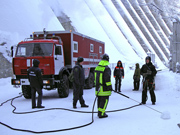High pressure hot water is sprayed from a special jet, effectively cutting and destroying the mass of snow and ice.
Steps are taken by Ministry of Emergencies of Russia specialists and industrial climbers to break off the ice. Previously, on 29 January 2010, part of the ice that had built up on the crest of the dividing wall was removed by the EMERCOM rescue teams and specialists from NII Fire Safety using pneumatic jacks. Operations to remove the snow and ice build-up are always preceded by a complex of preparatory measures and detailed investigation of the state of the build-up.
There is a preliminary agreement in place for the Ministry of Emergencies personnel to continue working at the plant until the end of February.
The snow and ice cover on the HPP's structures appears as a result of a spray of water and air particles forming from the working service spillway and was exacerbated by low temperatures. The appearance of snow and ice masses was forecast by the plant's specialists immediately after the accident, when it became clear that the spillway part of the dam would be used to release the water during the winter period (in normal years, this is carried out through the plant part of the dam, with the water passing along the power conduits to the hydro-units).
During the autumn and winter period of 2009 - 2010, the service spillway was transferred to operating in basic fixed mode, with all the spillway valves set at an intermediate degree of opening, this ensuring that the reservoir operates naturally in accordance with the set timetable and guaranteeing sanitary releases into the tail race. Introduction of design modifications into the structure of the service spillway valves and their transfer to an optimal intermediate degree makes it possible to distribute the release set by the schedule evenly over the 11 spillways. The result is a considerable reduction in the load borne by the structures of the spillway basin and in the formation of water spray. Calculations made by the general designer (JSC Lengidroproekt) confirm the stability of the structure given such a water release scheme.
For the purpose of ensuring the safety and reliability of the hydro-engineering structures and units at the Sayano-Shushenskaya HPP, a whole complex of work is carried out at the plant during the winter period. Within the scope of the programme to reduce the snow and ice cover, active use is made of the natural salt bischofite, the high effectiveness and safety of which has been confirmed by a number of institutes (MADI, VNIITMASH and GiprodorNII). Bischofite prevents ice forming at a considerably lower temperature than the other anti-icing agents (down to -35С) and acts quickly - in 15 minutes, it melts twice as much ice as sodium chloride.
The Sayano-Shushenskaya HPP services have resolved the problem of icing up of the roof of the engine room by heating the area beneath the roof with specially acquired heaters with a total capacity of 1.5 MW and treating the roof surface with anti-icing agent. Maintenance of a positive temperature of the roof prevents a build-up of ice and facilitates the mechanical removal of any ice.
Snow and ice also builds up on the crane trestle. The load at the moment is about 100 metric tonnes per metre in length, while a permissible load is 400 metric tonnes a metre. In addition, the snow and ice that has built up on the crane trestle has a crumbly structure and is subject to constant natural washing away by the flow of water through the service spillway. In fact, these crumbly pyramids, washed away from beneath by the water flow, pose no danger to the crane trestle or other hydro-engineering structures.
On the power plant's structures and the adjacent territory, there are a total of over 11 000 measuring points where indicators of the state of the structure and its foundations are monitored and there are 6000 built-in detectors within the body of the dam itself. Both the automated systems and specialists of the service for monitoring the plant constantly and comprehensively analyse the state of the HPP's structures. Control indicators of the "dam-foundation" system changed in both December and January in accordance with changes in the level of the reservoir and the temperature regime of the environment: they complied fully with the required safety criteria. The blocks securing the bottom of the hydraulic jump basin are, according to the control and measurement apparatus readings, in a satisfactory condition.



